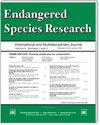Current water pollution status at an important wintering site of the black-faced spoonbill Platalea minor in Xinghua Bay, south China
IF 2.9
2区 环境科学与生态学
Q2 BIODIVERSITY CONSERVATION
引用次数: 0
Abstract
ABSTRACT: Xinghua Bay is one of the largest wintering sites of the black-faced spoonbill Platalea minor in mainland China. The ecosystem of Xinghua Bay has shown a deteriorating trend with the increasing pressure of economic development in recent decades. To understand the current conservation status of the wintering spoonbills in Xinghua Bay, we collected water samples along the coast of Xinghua Bay and important spoonbill habitats during the wintering period to analyze the pollution degree of 7 target heavy metals and organics. The Nemerow pollution index (NPI), heavy metal pollution index (HPI) and contamination degree (CD) were used to assess the heavy metal pollution levels. The ecological risk index of a target heavy metal (Efi) and potential ecological risk index of all target heavy metals (RI) were used to assess the ecological risk of heavy metals levels in Xinghua Bay. Positive matrix factorization (PMF) was used to determine the sources of heavy metals in coastal waters with the EPA PMF5.0 model. The results showed that there was moderate to very heavy pollution by heavy metals and moderate associated ecological risks in Xinghua Bay, in which Hg and Cd were the major heavy metal pollution sources, and the level of organic pollution was of serious concern. The use of fertilizers for cultured shellfish and aquaculture in and around the bay were the major cause of the excessive nitrogen and phosphorus levels, and factories surrounding Xinghua Bay were the major sources of heavy metals and organic pollution. We propose conservation measures to increase black-faced spoonbill population and enhance its habitats.中国南方兴化湾黑脸琵鹭重要越冬地的水污染现状
摘要:兴化湾是黑脸琵鹭在中国大陆最大的越冬地之一。近几十年来,随着经济发展压力的不断增大,兴化湾的生态系统呈现出不断恶化的趋势。为了解兴化湾越冬琵鹭的保护现状,我们采集了兴化湾沿岸及越冬期间琵鹭重要栖息地的水样,分析了7种目标重金属和有机物的污染程度。采用尼莫洛污染指数(NPI)、重金属污染指数(HPI)和污染度(CD)评估重金属污染程度。采用目标重金属生态风险指数(Efi)和所有目标重金属潜在生态风险指数(RI)评估兴化湾重金属污染水平的生态风险。利用美国环保署 PMF5.0 模型,采用正矩阵因子法(PMF)确定近岸海域重金属的来源。结果表明,兴化湾存在中度到极重度重金属污染和中度相关生态风险,其中汞和镉是主要的重金属污染源,有机污染程度严重。湾内及周边贝类养殖和水产养殖使用化肥是造成氮磷超标的主要原因,兴化湾周边工厂是重金属和有机污染的主要来源。我们提出了增加黑脸琵鹭数量和改善其栖息地的保护措施。
本文章由计算机程序翻译,如有差异,请以英文原文为准。
求助全文
约1分钟内获得全文
求助全文
来源期刊

Endangered Species Research
BIODIVERSITY CONSERVATION-
CiteScore
5.50
自引率
6.50%
发文量
38
审稿时长
31 weeks
期刊介绍:
ESR is international and interdisciplinary. It covers all endangered forms of life on Earth, the threats faced by species and their habitats and the necessary steps that must be undertaken to ensure their conservation. ESR publishes high quality contributions reporting research on all species (and habitats) of conservation concern, whether they be classified as Near Threatened or Threatened (Endangered or Vulnerable) by the International Union for the Conservation of Nature and Natural Resources (IUCN) or highlighted as part of national or regional conservation strategies. Submissions on all aspects of conservation science are welcome.
 求助内容:
求助内容: 应助结果提醒方式:
应助结果提醒方式:


